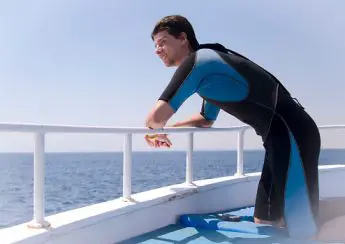Introduction
Quick Navigation
Scuba diving is more than just jumping into a water body and staying for some minutes underwater for the pleasure of it. Pleasure diving may not be all so serious; however, you need to check several things before you proceed on the professional level. The essence of doing this is to ensure you an optimum to a maximum level of safety.
If you don’t take these pre-diving precautions, you could be diving upward apart from your safety being compromised. One of the most crucial things to do is to take a pre-dive weight or buoyancy check. Divers with incorrect weighting may spend time adding air to BCD or floating upward.
Luckily, this article discusses the steps to take to complete a buoyance check successfully. It also explains other consequential things to do when diving.
What is Buoyancy?
Before you get right into conducting a weight check, you must understand what buoyancy means.
Buoyancy is the force that causes the floating of objects. It works using a law of Physics called Archimedes’ Principle of Fluid Mechanisms. It states that: “a wholly or partially immersed object in a liquid has a buoyant force that is equal to the weight of the fluid, displaced by the object.”
The effect of this Fluid Principle influences diving; hence, buoyancy is a force to overcome. Diving involves sinking below the surface, and to achieve that, a neutral buoyancy must be achieved.
What is Responsible for a Diver’s Buoyancy?
A diver’s buoyancy is influenced by several factors – almost everything you can imagine when going underwater. Some of these factors include the type of water, i.e., freshwater or saltwater, diver’s physiology, protective gear and its weight, air breathed out, and so on.
However, it is important to maintain neutral buoyancy for proper weighting, which ultimately means a fantastic diving experience. One of the ways to achieve that is reducing the weight on. If you don’t fix this weighting problem before diving, there is a good chance that you will go deeper than the planned depth. Also, you might be swimming diagonally instead of going in a streamlined direction.
Therefore, it is often advised that before any serious diving experience, proper weight checks are carried out for safety reasons.
Step-by-Step Guide to Complete a Pre-Dive Buoyancy/Weight Check
If you’ve picked a date to go professional scuba diving, you need to run through a quick weight check. The following steps teach you what to do in the easiest way possible.
Step 1: Gear Up
First, you need to gear up. Put on the necessary things you will need for diving – a wetsuit, scuba regulator, etc. While you are doing this, ensure that your BCD stays inflated.
Step 2: Practice Breathing Test
If you are set with the gear in place, the next thing to do is practice your breathing test. You should breathe in first and hold for a few seconds. While holding your breath, let out the air in your BCD slowly.
Step 3: Check Floating Level
In water, you should float at eye level. If that happens, that means you are properly weighted for the diving experience.
Still, either of the following could happen:
If you sink,
That means you are carrying excess weight. What you need to do is fully inflate the BCD and kick up to the surface. Remove a weight from your gear and repeat the above steps. You should be properly weighted after removing this weight.
If you float,
That means you need to add extra weight. Likewise, inflate the BCD while your head is at the surface. The moment you feel comfortable, add a weight to your belt or pocket and repeat the above steps.
What Tips Do You Need to Practice Weight Check?
By adding or removing a weight, you should float comfortably at eye level. Alongside, you will need some useful tips to practice.
Ensure that the aluminum cylinder tank is about 1.6 lbs. (when empty) and 2.8 lbs. (when full). Using Steel cylinders may limit buoyancy; thus, it is not advisable.
Examine your diving water area properly before you start
Keep a diving buddy close to assist you with weight adjustment
Get a PADI Scuba book to help you with accurate weighting
See how to deploy a surface marker buoy here.
What are the Common Mistakes Divers Make?
Over the years, divers have always made some mistakes when it comes to pre-dive weight checks. While some of them get lucky, others don’t. Below is a list of these mistakes and the solutions provided for better safety.
Kicking Up While Floating
One common mistake divers – amateur ones, mostly, make is kicking up when their head is above the water. It would help if you didn’t do this unless you are sinking. If you are floating, you are to remain calm while your legs hang underneath. Once you maintain a good balance, you can now add extra weight to give you a neutral buoyancy.
Poor Breathing Exercise
A significant thing that contributes to a proper weight check is breathing exercise. Many divers are fond of taking giants breaths, and it doesn’t do them any good. Instead of giant breaths, you are advised to take normal ones and hold them for as long as possible until you let the air out of the BCD.
Breathing Out with Air Out of the BCD
While holding your breath to free the air in the BCD, some divers make the mistake of breathing out. It is mostly because these divers are used to fighting for breath and cannot hold it for so long. However, if you constantly remind yourself not to breathe out while letting air out of the BCD, you should be doing a good weight check.
Not Kicking Up While Sinking
Like the floating mistake, many divers forget to kick up when their head is below the surface. It would be best if you did this to keep your head back at the surface to remove excess weight responsible for sinking.
Conclusion
By now, you should know why completing a pre-dive weight check is important for an incredible diving experience. More importantly, you should note these common mistakes and work on them to ensure your safety.

